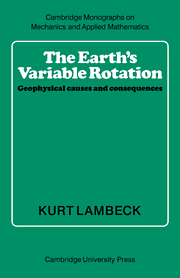Book contents
10 - Tidal dissipation
Published online by Cambridge University Press: 06 October 2009
Summary
Introduction
Tidal dissipation and its consequences on the lunar orbit and Earth's rotation have become a classic problem, yet there is probably no other subject in geophysics that has had as long a history of frustration and still attracts very considerable attention from geophysicists, astronomers and oceanographers. That this is so is as much a reflection of the fascination of the subject as an indication of a problem of some importance in understanding the origin and dynamical evolution of the Moon. In his Harold Jeffreys lecture, entitled ‘Once Again – Tidal Friction’, Walter Munk introduced the subject by saying that in 1920 it appeared Jeffreys had solved the problem of tidal dissipation but that we have gone backwards ever since (Munk 1968). Now, some 10 yr later, we have gone full circle, for once again there is agreement between observations and theory. Future new developments may mean that we have to go through the cycle of agreement and disagreement once more, before we can finally conclude that the subject is closed. But if these new results, such as those that may come from lunar laser-ranging analysis, disagree with our present knowledge we can always use Jeffreys' dictum ‘[The analysis] covers only a short interval of time and will probably be improved’ (Jeffreys 1973).
- Type
- Chapter
- Information
- The Earth's Variable RotationGeophysical Causes and Consequences, pp. 286 - 341Publisher: Cambridge University PressPrint publication year: 1980

